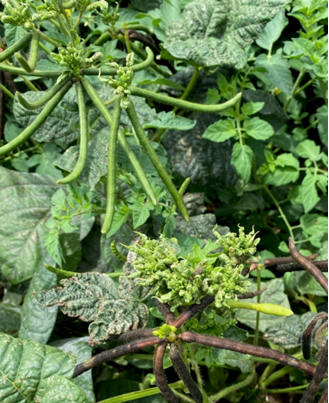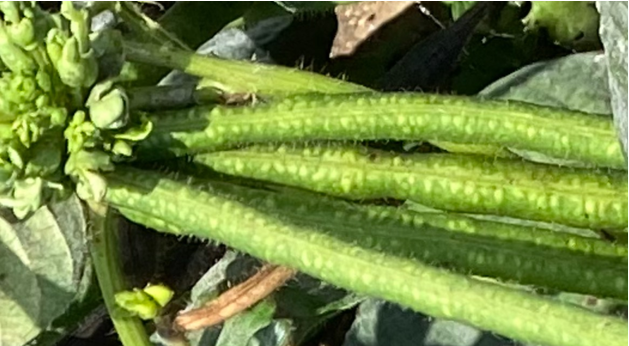
Phytoplasma affecting upper growth of advanced mungbean crop in Burdekin region (October 2022, photo: Gavan Lamb). Puffy pod affected plant is in upper left of image.
A severe outbreak of phytoplasma disease has been reported in mungbeans from the Burdekin region. Symptoms of little leaf, phyllody (greening of flower structures) and puffy pod became obvious in mid-late October and have now affected a high incidence of plants in a 25 ha planting. Puffy pod affected plants typically remain green for longer than healthy mature plants. This may affect timing of desiccation. Growers are advised to check for puffy pod affected plants that are unlikely to ripen evenly and may have poor quality seed, so that timing of desiccation and harvest can focus on the healthy plants that will reach black-pod stage sooner.
Outbreaks of phytoplasma in mungbean are sporadic but appear to have increased in regularity since about 2016. Growers in the Burdekin region and other growing regions are advised to be aware of potential symptoms in mungbean and other susceptible crops such as soybean.
Good farm hygiene to reduce possible weed reservoirs for both the disease and its leaf hopper vectors is recommended as control options for this disease are limited.

Puffy pod affected mungbean showing mottling and net-like patterns on pods that contain small seeds (Burdekin region, October 2022. Photo: Gavan Lamb).
If you see concerning symptoms in mungbean (or other legume crops) from any region, please contact plant pathologist Murray Sharman ([email protected], 0467 721 400) or Lisa Kelly ([email protected], 0477 747 040) for further information on disease diagnosis.
Further information on phytoplasma in mung bean and soybean can be found in the Beatsheet’s previous articles including:
